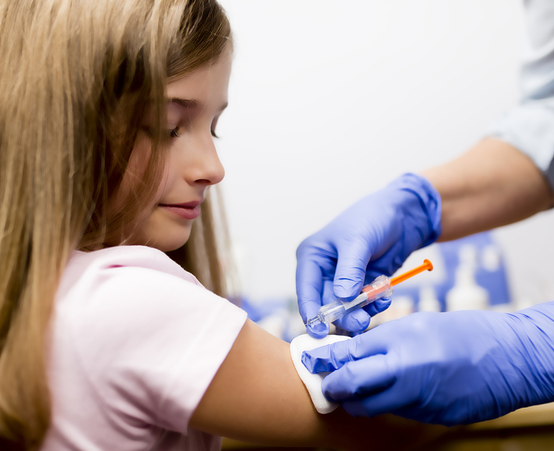Human papillomavirus (HPV)

Human papillomavirus (HPV) is a group of viruses that are very common worldwide. Certain strains can lead to cancer in females and males.
There are more than 100 types of HPV. They’re often transmitted sexually or through skin-to-skin contact. Although rare, a mother with HPV can transmit the infection to her child during birth.
Most HPV infections don’t pose problems but some progress to cancer. The virus causes more than 95 per cent of cervical cancer globally.
After infection, it can take a decade for cervical cancer to develop in girls and women with normal immune systems or as little as five years for those with weakened immune systems.
Immunising children and adolescents against HPV, particularly girls aged nine to 14, protects against HPV infection. Vaccination prevents a majority of cervical cancer plus cancers of the vagina, vulva, penis, anus, head, neck and throat, and benign lesions such as genital warts.

Who does it affect?
Who does it affect?
- HPV infection is the most common viral infection of the reproductive tract and affects women and men. Four out of five sexually active women are infected at least once in their lifetime.
- The peak time for acquiring infection is adolescence, soon after becoming sexually active.
- Cervical cancer is the fourth most common cancer in women worldwide. There were 604,000 new cases in 2020.
- In some countries, including Fiji, cervical cancer is the most common cause of cancer in women.
- High-risk groups such as those living with HIV are at a much greater chance of developing cervical cancer.
Our HPV research
Our HPV research
We are conducting several studies in resource-poor countries to determine the burden of cervical cancer, the prevalence and types of HPV, and the impacts of introducing vaccination programs.
In Vietnam, we are undertaking studies to reduce HPV transmission by vaccinating high-risk groups such as those with multiple sexual partners. Over the past five years, we have expanded our research to other countries, with projects in Mongolia, Malaysia, Thailand, India and Ethiopia. We are studying the prevalence of different HPV types, cancer burden and vaccine cost-effectiveness and attitudes.
A major program of our research is aimed at applying cutting-edge technologies to better understand the immune response after a single dose of HPV vaccine and providing evidence to support this schedule. We are studying the effectiveness of a single dose of HPV vaccine in Fijian women. HPV vaccination was introduced to Fiji in 2012-2013 but it takes 10 to 20 years to show effects on cancer rates, so the study is ongoing.
The standard regimen is two to three doses but because the vaccine is expensive and delivery of multiple doses in resource-poor settings is challenging, we are investigating if one dose would be a more cost-effective way of enabling widespread coverage and reduction of cervical cancer in resource-poor countries.
Impacts of our research

Impacts of our research
- We facilitate the National HPV Monitoring Program to track the prevalence of infection and the effectiveness of Australia’s National HPV Vaccination Program. Preliminary data indicate huge reductions in virus prevalence in women under 35. Reductions in HPV in young, unvaccinated men were also observed, suggesting high levels of herd protection were achieved by the female-only vaccination program before it was extended to boys. Genital wart infection rates have also dropped due to fewer HPV infections.
- Our work underpinned Fiji's decision to introduce HPV vaccination. We are working with Fiji’s Health Ministry to evaluate the program. Vaccination has led to fewer cases of common cancer-causing HPV strains being detected. The study demonstrated that six to seven years after vaccination, protective antibody levels were similar after two and three doses in girls.
- Emerging evidence suggests a single dose may protect against infection and pre-cancerous changes in the cervix. We provided some of the first evidence of the potential benefit of one dose in Fiji and Mongolia.
- We assessed the impact of the HPV vaccination pilot program in Mongolia, which provided evidence to the Mongolia Government to re-introduce the HPV vaccine into the National Immunisation program.
- Improving vaccine uptake is vital as research by others shows high rates of vaccination, screening (Pap smears) and treatment can reduce cervical cancer deaths by 99 per cent this century, saving 62 million lives.
- Four of our research articles have been cited by the World Health Organization and the Single Dose HPV Vaccine Consortium as evidence to support the formal evaluation of the single-dose HPV vaccine schedule.
Our vision
Our vision
Our mission is to continue finding ways to improve HPV vaccination programs to reduce the global burden of cervical cancer and HPV infections. Our vision for the future is the elimination of cervical cancer in line with WHO’s strategy.
Where to next?
Where to next?
More than 70 per cent of low and lower-middle-income countries still do not have access to the HPV vaccine. There is an urgent need for increased uptake of HPV vaccination in these countries, including many countries in the Asia-Pacific region. We are continuing to gather important evidence on the use of single-dose HPV vaccine schedules to improve vaccine access. Our work also involves accurately measuring the burden of HPV-associated diseases in resource-poor countries (which is often lacking). This information is needed for the implementation of appropriate public health measures and to measure the HPV vaccine impact.



